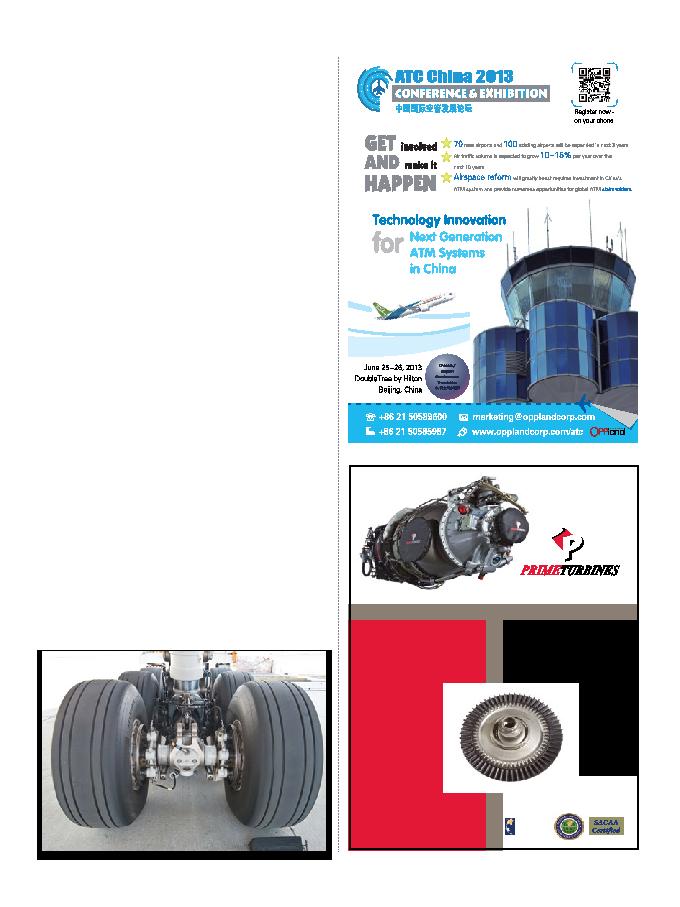
2013 APRIL / Vol. 5 / No. 4 /
GA
15
rim supports the tire's profile.
Sidewall and shoulder
The sidewall is that part of the tire
that bridges between the tread
and bead. The sidewall is largely
rubber but reinforced with fabric
or steel cords that provide for
tensile strength and flexibility.
The sidewall contains air pressure
and transmits the torque applied
by the drive axle to the tread to
create traction but supports little
of the weight of the vehicle, as is
clear from the total collapse of the
tire when punctured. Sidewalls are
molded with manufacturer-specific
detail, government mandated
The shoulder is that part of the
tyre at the edge of the tread as it
makes transition to the sidewall.
Ply
Plies are layers of relatively
inextensible cords embedded in
the rubber to hold its shape by
preventing the rubber from stretching
in response to the internal pressure.
Aircraft tyres are designed to
withstand extremely heavy loads
for short durations. The number
of tyres required for aircraft
increases with the weight of the
plane (because the weight of the
airplane has to be distributed
better). Aircraft tyre tread patterns
are designed to facilitate stability
in high crosswind conditions, to
channel water away to prevent
hydroplaning, and for braking effect.
Aircraft tyres are usually
inflated with nitrogen or helium
to minimize expansion and
contraction from extreme changes
in ambient temperature and pressure
experienced during flight. Dry
nitrogen expands at the same rate
as other dry atmospheric gases, but
common compressed air sources
may contain moisture, which
increases the expansion rate with
temperature. Aircraft tires generally
operate at high pressures, up to
200 pounds per square inch (14
bar; 1,400 kPa) for airliners, and
even higher for business jets.
Tests on aircraft tyres have
shown that they are able to sustain
pressures of maximum 800 pounds
per square inch (55 bar; 5,500 kPa)
before bursting. During the test the
tyres have to be filled with water,
instead of helium or nitrogen,
which is the common content of
aircraft tyres, to prevent the test
room being blown apart by the
energy when the tyre bursts.
Aircraft tyres also include heat
fuses, designed to melt at a certain
temperature. Tires often overheat if
maximum braking is applied during
an aborted takeoff or an emergency
landing. The fuses provide a
safer failure mode that prevents
tire explosions by deflating in a
controlled manner, thus minimizing
damage to aircraft and objects in
the surrounding environment.
The requirement that an inert gas,
such as nitrogen, be used instead of
air for inflation of tires on certain
transport category airplanes was
prompted by at least three cases in
which the oxygen in air-filled tires
combined with volatile gases given
off by a severely overheated tire and
exploded upon reaching autoignition
temperature. The use of an inert
gas for tire inflation will eliminate
the possibility of a tire explosion.
Auto braking
An aircrafts auto braking and anti
skid systems are designed to slow
the machine down at a constant rate
given the runway still available.
In this way the brakes and tyres
are saved. Most passenger aircraft
have reverse thrust and spoilers
to aid this process. The latest
systems on the newest products
include BTV brake to vacate
you program a vacate taxiway into
the electronic flight bag and the
systems through the auto braking
deploy optimal braking so as to
bring the aircraft to a smooth stop
by the particular taxiway selected
by the flight crew. This saves on
tyre wear and time on the runway. ·
It's Your Choice...
Prime Turbines is an
independent, FAA authorized
overhaul facility. We're not
confined to the OEM's limiting
policies, and you shouldn't be
either. You deserve to choose
your MRO facility and find
value-saving alternatives.
From fuel nozzle flow to
engine overhaul, Prime
Turbines gives you the
options you need. Each engine
is different, which is why we
are dedicated to serving your
individual needs.
Explore the alternatives...
call Prime Turbines.
ENGINE OVERHAUL
POWER SECTION
ENGINE TESTING
HOT SECTION
GAS GENERATOR
FUEL NOZZLES
M.O.R.E.
PROGRAM
BLEED VALVE
www.primeturbines.com
PT6A Repair & Overhaul
Fernand Foisy
ffoisy@primeturbines.com
Mobile: +27 8573 9842
EASA
